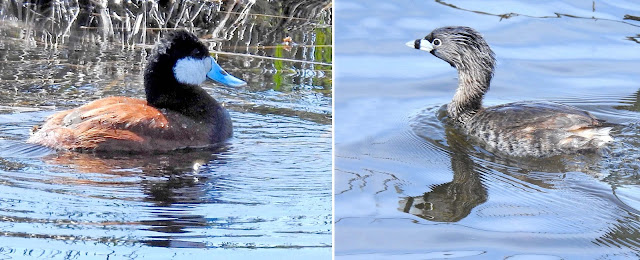Sandhill Crane Couple - Antigone canadensis
This week my friends Rod and Rochelle and I went on our annual Spring trip to Sierra Valley. Every year we see something unexpected, and this year was no exception! We were a little bit early for the a lot of the songbirds, but the waterfowl were numerous! It was a beautiful blue-sky day with a hint of clouds, and lots of water in the Valley! Right away we started seeing pairs of Sandhill Cranes! The pair pictured above were foraging on the edge of the wetlands. They are mainly herbivores, but will also prey on small mammals, insects, snails, reptiles, and amphibians. Sandhill Cranes are one of North America's large birds. They are approximately 4 feet tall, weigh 10 lbs, and have a wingspan of up to 7 feet!
Sandhill Crane Couple Mating! - Antigone canadensis
As we were driving along, I spotted a pair of cranes on dry land. One of the cranes had its wings outstretched. We hadn't ever seen this behavior before so we stopped to see what might happen. To our complete surprise, the crane to the left hopped up on top of the one with the outstretched wings and they mated! The mating lasted for just a few seconds, and then the male hopped off the female! WOW!!! Sandhill Cranes mate for life, and probably mate many times during the breeding season. Although most of the Sandhill Cranes that overwinter in California breed farther north in Idaho, Oregon, and Washington, a dozen or more pairs mate and raise their young in Sierra Valley. They build their nests out of dried vegetation on small dirt "islands" in the wetlands, or floating right on top of the water! There are 1-3 eggs laid in a clutch. The incubation period is approximately 30 days, and both the male and female share the incubating. The young are born precocial (covered in down with eyes open) and can leave the nest within one day after birth! They usually stay together as a family group for 9-10 months. We'll have to come back in a month or so to look for some young Sandhills! Now that would be something!
American Wigeon Couple - Gadwall (male)
Mareca americana - Mareca strepera
We saw a lot of ducks in the wetlands! Most numerous were the Greater White-fronted Geese, and the Canada Geese. They were all gorgeous! Here are a few photos of what we saw! Enjoy!
Ruddy Duck (male) - Pied-billed Grebe (adult)
Oxyura jamaicensis - Podilymbus podiceps
Canada Geese (adults) - Greater White-fronted Geese (adults)
Branta canadensis - Anser albirons
Sage Thrasher (adult) - Western Meadowlark (adult)
Oreoscoptes montanus - Sturnella neglecta
Songbirds and Raptors weren't prevalent, but we did see lots of Red-winged Blackbirds, as well as several Sage Thrashers and Western Meadowlarks! Such beauty!
Here's a short video of a 100+ Red-winged Blackbirds singing away in one of the few Cottonwoods in Sierra Valley! Unfortunately the wind noise is distracting, but the birds sound like a lot of tinkly windchimes! (To view the video, select the arrow twice.)
Around 2:00 in the afternoon, Rochelle spotted a HERD of American Pronghorns in the sagebrush! WOW!!! We had never seen this many Pronghorns together in one group! I couldn't get an accurate count, as they were in a sagebrush thicket, but there were somewhere between 15 and 20 individuals! Most of them looked like females! Of course they didn't linger, and quickly headed east and out of sight! They were absolutely amazing to watch! We couldn't believe our luck!
American Pronghorn (females) - Antilocapra americana
Pronghorns are not antelopes, and are not related to antelopes, but are often known colloquially in North America as the American antelope, prong buck, pronghorn antelope, prairie antelope, or simply antelope. They are the ONLY species in their Antilocapridae Family, and the only animal on earth that has branching horns that are shed annually. They are more closely related to giraffes than to the antelopes that are indigenous to various regions in Africa and Eurasia, comprising of many species of even-toed ruminants such as gazelles. Many (but not all) pronghorn herds are migratory, traveling long distances to warmer climates in the fall, and back to greener locations in the spring.
American Pronghorn (female - male) - Antilocapra americana
Their horns are keratinized sheaths which cover extensions of the frontal bone. The sheaths are shed annually. Both male and female have these horns. The horns of the males grow up to 11.8–19.7 inches, female horns are smaller at 2.9-3.9 inches. Males have lyre-shaped horns that curve inwards whereas females usually have straight horns. The female's horns are generally smaller than their ears, or absent, and aren't pronged. Additionally males have short black manes on their neck, as well as a neck patch and a black stripe that runs across their forehead from horn to horn. Females lack these black facial patches, but have a small mass of black hair around their nose. Breeding doesn't occur until mid-September to October when males acquire small harems of females. One to two offspring are born the following spring. They are usually weaned in three weeks, but will remain with their mother for a year and a half. What a thrill it was to watch these amazing, wild, native mammals!
American Pronghorn (females) - Antilocapra americana
These beautiful Pronghorns are the swiftest animals in North America, and have been recorded running as fast as 59 mph! They can outrun any predator! Their limbs are cursorial (built for speed) but not for jumping. Fences have had a detrimental effect on their population, as they cannot jump over them. They need to live in areas that are wide open and basically treeless, like Sierra Valley. They feed on a wide variety of plants, especially sagebrush in the winter.
Coyote - Canis latrans
To our delight we spotted a Coyote close to the road! It quickly trotted away and out of sight, but I managed to get one good photo! It looked like it still had its thick winter coat! Coyotes mate in late January and are monogamous during the breeding season. Their dens are dug by the female and can have several entrances and passages that branch out from the main chamber. They may dig a new den, use an abandoned badger or skunk den, or den in a hollow tree or under a rock ledge. The pups are born about 2 months after mating, with 6 pups per litter being the norm. The male coyote brings food to the female during the nesting period, and also helps with the feeding, grooming and guarding of the pups. They eat deer, rabbit, hares, rodents, birds, reptiles, amphibians, insects and fruits.
We had a beautiful day out in Sierra Valley, and plan to return soon! How lucky we are to have this spectacular valley so close to home!
Sky Lupine covered hillside - inset: Frying Pans, Sky Lupine, Bird's Eye Gilia
Escholzia lobbii - Lupinus nanus - Gilia tricolor
Last week I went to North Table Mountain Ecological Preserve with some friends to see the spring wildflowers. It is a flat-topped butte, next to the town of Oroville, Ca., the top of which is capped by an ancient lava flow. It became an ecological preserve in 1993, when Francis Carmichael, a local rancher, sold 3,315 acres of it to the State of California, to be managed by the California Department of Fish and Wildlife. Now it is open to the public. Compared to last year it was quite dry, and the bloom wasn't as spectacular but still very beautiful!
Horned Lark (male) - Eremophila alpestris
This Horned Lark was foraging for insects and seeds among the dry grasses and forbes when we spotted him. I love their little, black, feather "horns"! These birds are sexually dimorphic, with the male being more colorful. They prefer to live in bare or nearly bare ground, such as tundra, desert, beach or short-grass prairie. Usually they travel in flocks of several hundred birds, except during the breeding season. Right now they are pairing off, mating, and making nests. Nests are made out of dry grasses, rootlets, animal hair and feathers, in a shallow depression on the ground. The female incubates 2-5 eggs for 11-12 days. The nestlings are altricial when born, and are cared for by the parents for 8-10 days after they fledge. The fledglings can run much sooner than they can fly. They are completely independent in four weeks.
Basalt Columns in a Dry Landscape - Canyon Delphinium (inset)
Delphinium nudicaule
Some areas were exceedingly dry, with flowers growing only in the damp creek beds or shaded forested areas. Luckily the beautiful vermillion-red Canyon Delphinium was in bloom in the shaded side of a canyon. Table Mountain is the only place where I've seen these gorgeous flowers!
Lark Sparrow (adult) - Chondestes grammacus
Unlike the Horned Lark, Lark Sparrows aren't sexually dimorphic. Similar to the Horned Lark they build their nests on bare ground, or slightly above ground in a shrub, in habitats like Table Mountain. Right now is their breeding season, and males are known to give a female a twig during copulation, which she then flies off with and places in her nest! 3-6 eggs are laid per clutch, and hatch within 12 days! Both male and female adults feed the nestlings, which can fly within 9 days! I love the markings and colors of the adults! Beautiful!
The creek leading to Ravine Falls - Table Mountain Meadowfoam (inset) Limnanthes douglassi ssp. nivea
There was only one creek that we passed that had some running water! We often found large patches of white Meadowfoam flowers filling damp or wet creek beds!
unknown butterfly
There were a zillion insects pollinating the flowers including these tiny butterflies. I don't know what species they are, but I will submit an inquiry on bugguide.net.
Frying Pans, Sky Lupine, Purple Owl's Clover and Bitterroot (inset)
Escholzia lobbii - Lupinus nanus - Castilleja exserta - Lewisia rediviva
After several hours of hiking we head back to our car, passing fields of poppies, lupine, and owls clover on the way. We also luckily found some blooming Bitterroots at the last minute! It was a wonderful day with friends, filled with beauty from start to finish! We are SO lucky!
Scarlet Fritillary in the Rain - Fritillaria recurva
Damp Earth Art
We got .10" of rain this week and it was cloudy and cooler. Yay! Anything helps! Please join me in my continuing hope for precipitation! Perhaps our collective efforts may help it happen. I'm going to keep posting rain inspired writings, art, etc. on my blog at dampearthart.blogspot.com. Any submissions would be greatly appreciated.
Wishing for peace in Ukraine and
an immediate end to this senseless war!
What insects are active now that it's warmed up?
What's going on in the Lakes Basin?
What songbirds have newly arrived?
Check back next week for the answers to these questions and more!
Unfortunately, you can no longer sign up to get my blog via email. Just go to northyubanaturalist.blogspot.com directly. It looks better than the emailed version!
Your questions and comments are greatly appreciated. Please feel free to email me at northyubanaturalist@gmail.com. Thanks!




















No comments:
Post a Comment